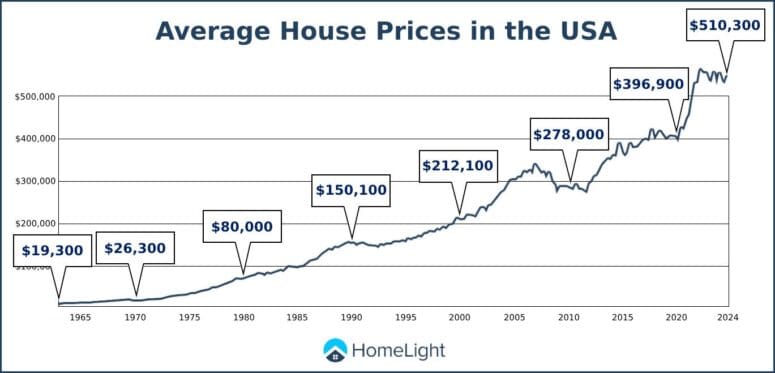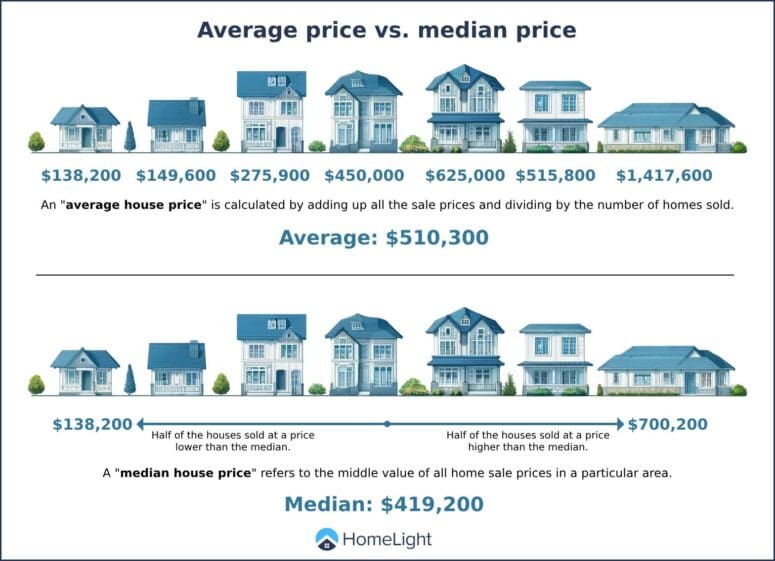What’s the Average House Price in the USA?
- Published on
- 6 min read
-
 Richard Haddad Executive EditorClose
Richard Haddad Executive EditorClose Richard Haddad Executive Editor
Richard Haddad Executive EditorRichard Haddad is the executive editor of HomeLight.com. He works with an experienced content team that oversees the company’s blog featuring in-depth articles about the home buying and selling process, homeownership news, home care and design tips, and related real estate trends. Previously, he served as an editor and content producer for World Company, Gannett, and Western News & Info, where he also served as news director and director of internet operations.
As a homeowner, every mortgage payment you make is an investment in yourself. Even if only a small portion of it goes toward your principal loan balance, it’s typically better than paying rent. If you were to sell your home today, how would your investment stack up against the average house price in the USA?
In this post, we’ll look at the current numbers, how house prices have changed over time, and how to get a more personalized estimate for your property.
What’s the average house price in the USA?
As of this publication date, the average house price in the U.S. is $510,300, based on the most recent data from the U.S. Census Bureau and the U.S. Department of Housing and Urban Development. This figure reflects the average sales price for homes nationwide and provides a general benchmark, though it doesn’t tell the full story for every market or property type.
Keep in mind that the average price is different from the median home price, which is currently $419,200. The average can be skewed by a small number of expensive home sales, especially in places like California or New York. But it’s still useful for getting a broad sense of where the housing market stands across the country. (We’ll look closer at average vs. median prices in a minute.)
How has the average house price in the USA changed?
Home prices have seen significant growth over the past few decades, and even more so in the past five years. In 2000, the average house price in the USA was $212,100. By 2010, even after the housing market crash, it had climbed to around $278,000. And by 2020, it jumped to roughly $396,900. Then came the dramatic pandemic-era increases. By the end of 2024, the average house price was at $510,300. This represents a 141% increase in 25 years.

The lift in home prices in the USA has been influenced by limited inventory, low interest rates, increased buyer demand, and inflation. The COVID-19 pandemic also had a major impact, driving up prices in most markets due to historically low mortgage rates (down to 2.65% in January 2021) and a surge in remote work.
While the overall rate of growth has cooled somewhat in recent years (mostly due to higher mortgage interest rates), average prices remain fairly high compared to previous decades.
Average house price vs. median home price
As you research and compare house prices to your own home, it’s helpful to know the difference between average and median values. Let’s review these math terms from our school days:
- Average house price is calculated by adding up all the sale prices and dividing by the number of homes sold. This metric can be useful for seeing overall trends in the market, but it can be skewed by a handful of high-priced sales.
- Median home price is the middle point — half of homes sold for more, and half sold for less. It gives a more accurate snapshot of the market, especially in areas with wide price ranges.
For example, while the average house price in the USA is about $510,300, the median home price is only $419,200 as of early 2025. Median pricing can often provide a better sense of what a typical buyer or seller might expect.
How do average house prices vary by state?
Average home prices can vary a lot depending on where you live. For instance, prices in coastal states or urban centers are often much higher than those in rural or Midwest areas.
Here’s a quick snapshot of average year-end home prices in a few states, according to Zillow data analyzed by the Motley Fool Money team:
- California: $791,663
- New York: $458,048
- Texas: $301,375
- Florida: $408,921
- Kansas: $225,669
These numbers show how location plays a huge role in real estate value. That’s why comparing your home to national averages can only go so far — it’s more helpful to understand trends in your local market.
Find the average house price in your state
You can check your state’s average home value using the interactive map below:
Note: Average house prices in the USA differ depending on which source you’re using. For example, average home prices reported by Federal Reserve Economic Data (FRED) will not be the same as average home prices presented by Zillow. Many other sources, such as the National Association of Realtors (NAR), prefer to track and report median home prices rather than averages.
What impacts average house prices in the USA?
Along with location, other factors that can influence the average house price in the USA include:
- Supply and demand: Fewer homes on the market typically drive up prices.
- Interest rates: Lower mortgage rates make borrowing cheaper, increasing buyer demand.
- Economic conditions: A healthy economy with low unemployment and rising incomes typically leads to higher house prices.
- Inflation: Along the same vein, as the cost of materials and labor goes up, so do house prices.
- Population trends: Areas with strong job growth or population increases often see higher prices.
- Government policy: Tax incentives, zoning laws, and interest rate decisions can all impact pricing.
How can I estimate my home’s value today?
To get a ballpark idea of your home’s value, try HomeLight’s Home Value Estimator. It uses public data, market trends, and recent sales in your area to give you a quick, preliminary estimate. While it’s not a formal appraisal, it’s a smart (and free) starting point if you’re thinking about selling or just curious about where you stand.
You can also use HomeLight’s Net Proceeds Calculator to estimate how much you might make from a sale after costs like agent fees, closing costs, and mortgage payoff.
Ask a top agent for a CMA to price your home
If you’re serious about selling, your next step is to connect with a top local agent. A trusted real estate agent can provide a comparative market analysis (CMA) — a detailed report that looks at similar properties in your area, recent sales, and current listings to help you price your home right.
HomeLight can match you with a top-performing agent in your area who knows your local market inside and out. With the right agent and accurate pricing, you’ll be in a strong position to sell your home quickly and for top dollar.
Header Image Source: (Jane Sorensen / Unsplash)



